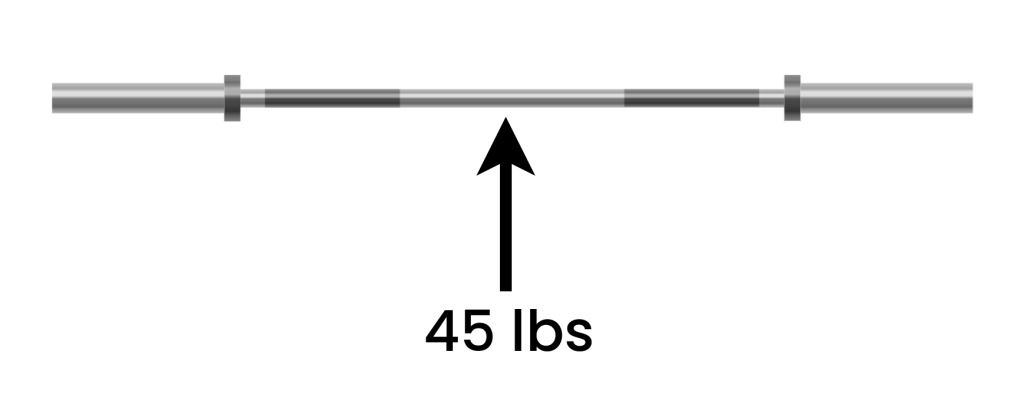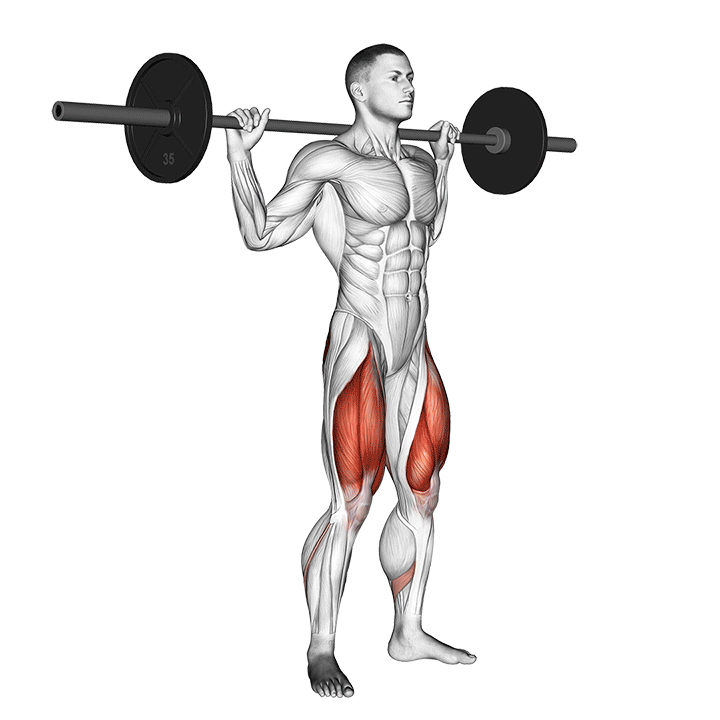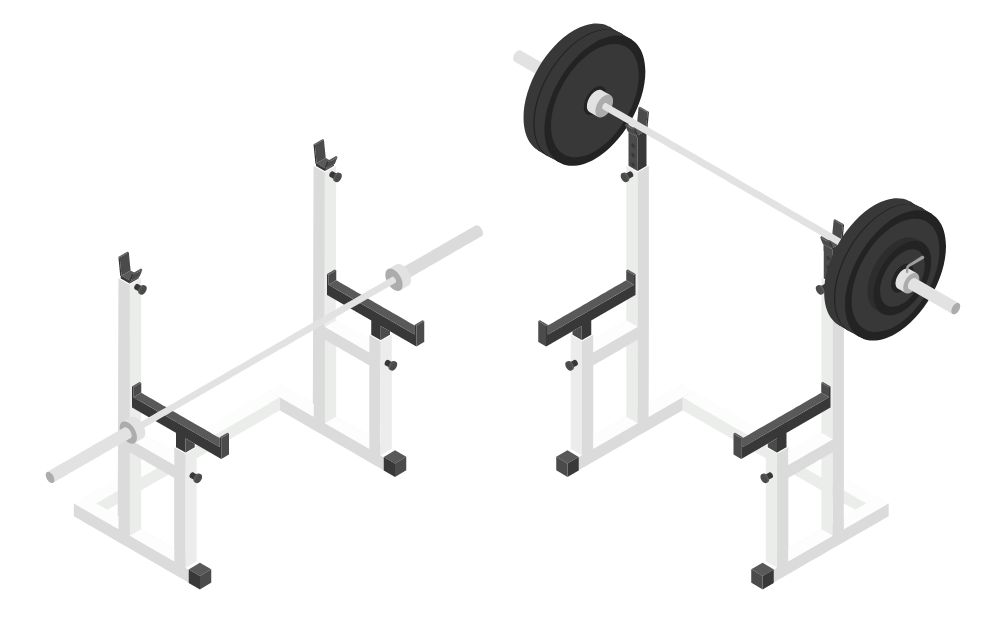How Much Does Squat Bar Weigh? Usually 45 lbs (20 kgs)
With all the different types of barbells out there, it’s no surprise that some information can get lost in the noise. One particularly confusing - and rather important - aspect is the actual weight of a squat bar while it is unloaded.
Though it differs depending on the type of bar and its purpose, the conventional squat bar is usually the Olympic barbell standard of 45 pounds (20 kilograms).
If you have a squat bar in your gym, chances are that it weighs 45 pounds or 20 kilograms while unloaded - though other types of bars like training bars, women’s bars or safety bars will weigh a different amount.
What is a Squat Bar?
Suffice to say, a “squat bar” is simply a standard barbell with which a barbell back squat may be performed. This will usually be an Olympic barbell or powerlifting barbell, both of which are several feet long and are manufactured to weigh 44-45 pounds (20 kilograms).

These barbells are immediately identifiable as they are often longer and heavier than other barbells, and will feature knurling with a smooth stretch in the middle of the bar.
Competitive powerlifters, strongman athletes, Olympic weightlifters and other types of weightlifting athletes will often use the standard Olympic barbell in both training and competition, hence its widespread usage in nearly every gym.
When is a Squat Bar Needed?
A squat bar is needed when the lifter intends to perform a back squat with more weight than they can reasonably hold, such as if their squat strength has surpassed how much they can carry in the form of dumbbells.

Furthermore, barbell-based squat exercises are considered to be more effective than non-barbell variants for the simple reason that the weight is distributed vertically from the top of the body, allowing for a more advantageous stance to be used.
Does the Squat Bar Weight Even Matter?
Yes - understanding how much weight is being lifted is of vital importance, as tracking your progression through steadily increasing weight is the most basic form of training progression.
Knowing the weight of the barbell being used allows lifters to not only track their progression, but also get a baseline as to where they are in comparison to other lifters of their weight and gender.
Furthermore, it is entirely possible for novice lifters to attempt squatting with the wrong type of barbell, potentially injuring them if they exceed their safe working load.
How is a Squat Bar Used?
Straight squat bars are used by simply being placed on a barbell rack and having a pair of plates affixed on either side of the bar.

When used for the conventional back squat, the bar will be placed atop the trapezius or shoulder-shelf of the lifter, and will remain there until the set is complete.
What are the Different Kinds of Barbells Used in Squats?
The term “squat bar” actually refers to several different types of straight barbells used for squatting.
While the general shape and usage of these bars remain the same, they can occasionally differ in weight from the standard 45 pounds (20 kilograms), and as such it is important to learn the difference between each so as to avoid any mistakes in programming.
1. Powerlifting Barbells
The powerlifting barbell is nearly identical to the standard Olympic barbell, only with somewhat sterner materials that are less prone to bending or "whipping" when very heavy loads are placed on the bar.
It is often preferred by high-level strength athletes, especially for exercises like the barbell or squat where the amount of weight loaded can potentially damage a standard barbell. Occasionally, powerlifting bars may be made thicker or longer than standard Olympic barbells as well.
Weight of a Powerlifting Barbell
Powerlifting barbells are usually the same weight as an Olympic bar; 44-45 pounds or 20 kilograms.
How to Use for Squats
Using a powerlifting barbell for squats is much the same as any other straight barbell. The lifter will unrack it atop their trapezius or the back of their shoulders before proceeding with the exercise.
2. Olympic Barbells
Olympic barbells are the most common barbell available, and are likely the only type of barbell that will be found in commercial gyms. They are usually longer than 6 feet long, and are considered the “standard” type of barbell, especially where squats are concerned.
Weight of an Olympic Barbell
Olympic barbells weigh 44-45 pounds or 20 kilograms.
How to Use for Squats
To use an Olympic bar for squats, the lifter will simply unrack it atop their trapezius or the back of their shoulders, using both hands to secure it in place atop their back.
3. Women’s Olympic Barbells
Women’s Olympic bars are much the same as standard Olympic barbells, only with a somewhat shorter length and thinner diameter so as to better accommodate individuals of smaller proportions.
They are functionally and mechanically identical to Olympic bars, and may be used as such.
Weight of a Women's Olympic Barbell
Women’s Olympic barbells weigh 33 pounds or 15 kilograms when unloaded.
How to Use for Squats
Using a women’s Olympic bar for squats is much the same as any other straight barbell, with the lifter unracking them atop the back.
4. Safety Barbells
Safety barbells are quite distinct in appearance from other types of barbells, as they will feature a pair of forward-facing handles attached to one side of the bar as well as a small bend on both ends of the bar so as to displace the weight in a different manner.
As can be guessed from its name, the safety barbell is meant to be used so as to reduce any risk of injury or accidents occurring, making it especially useful for home-based lifters or novices new to squatting in general.
Weight of a Safety Barbell
Safety barbells will differ in weight by brand, though the average safety bar will weigh anywhere between the standard 44 pounds (20 kilograms) up to 70 pounds (approx 32 kilograms).
Because of the high variability between safety bar brands, it is a good idea to weigh the barbell before using it for squats so as to avoid errors in loading.
How to Use for Squats
In order to use a safety bar for squats, the lifter will need to step beneath the front-facing handles of the bar and grip them with both hands, ensuring the straight portion is atop their back as they do so.
The lifter’s torso should be facing away from the bar, in line with the front-facing handles. The neck will effectively be surrounded by the barbell, with only the front of the neck being left open.
Once the bar is secure atop their shoulders and back, they may proceed with the squat.
5. Cambered Barbells
Cambered squat bars may appear visually similar to a safety barbell, but differ in the way that they do not have forward-facing handles, and are more akin to a trap bar that has been split in half.
Cambered squat bars will feature a unique shape that alters the displacement of the weights through the bar, and may be more comfortable - if not safer- than standard straight barbells used for squatting.
Weight of a Cambered Barbell
Like safety barbells, cambered barbells will vary in weight depending on what brand has manufactured them. Among the lightest cambered bars are those that weigh 40 pounds (18 kilograms), though there are some bars that can weigh up to 80 pounds (36 kilograms).
How to Use for Squats
To use a cambered barbell for squatting, the lifter may unrack the bar atop their back just like any other straight barbell - though they may wish to use a neutral grip along the angled portion of the bar, rather than on the straight portion.
Due to the shape of the cambered barbell, lifters may wish to adopt a somewhat wider stance with their squat so as to better balance themselves.
What is the Difference Between Squat Bars and Other Barbells?
For the most part, there is no special barbell specifically for performing the squat. The majority of lifters will simply make use of a straight Olympic barbell and ignore any minute differences between the different types of barbells.
When comparing the aforementioned barbells that may be used as a squat bar, we can see that they all feature one thing in common; a straight portion that allows the lifter to place the bar atop their back.
So - what is the difference between barbells for squatting and barbells that are incompatible with the conventional back squat? The capacity to be placed atop the back.
As such, barbells like the hex bar, EZ-curl barbell and multi-grip barbell are decidedly not squat bars, simply because they cannot be feasibly placed atop the back of the lifters and must be held in order to be used for squats.
How to Squat if the Barbell is Too Heavy
In the event that the only available barbells in the gym are too heavy to squat with, it is entirely fine to begin with lightweight dumbbells.
Doing so will allow the lifter to build their strength up to the point where they may be able to squat with an unloaded barbell, before they can then transition to loading the barbell with low-weight plates.
Frequently Asked Questions (FAQ)
Are All Squat Bars 20 Kilograms?
No - not all barbells used for squatting weigh 20 kilograms (44 pounds). Some kinds of squat bars like the women’s Olympic barbell or training barbell will weigh less, often being 7-10 kilograms (15-22 pounds) depending on what brand has manufactured them.
Do You Include the Bar Weight in Squats?
Yes - when recording the amount of weight you have lifted, the barbell is counted in the total.
For example, a standard Olympic barbell with two 45 pound (20 kilogram) plates loaded at either side will weigh a total of 135 pounds (61 kilograms).
Are All Barbells 45 Pounds?
No, not every type of barbell weighs 45 pounds or 20 kilograms. While this is the standard, other types of specialty barbells may weigh more or less.
Final Thoughts
Keep in mind that not all barbells are the same - even among those of the same brand. The only surefire way of knowing how much a barbell actually weighs is to measure it yourself.
And, unless you are a specialty athlete or a total novice, it is better to stick with the Olympic straight barbell, as it is the most straight-forward to use and will help teach basic squat mechanics in the most efficient way possible.
